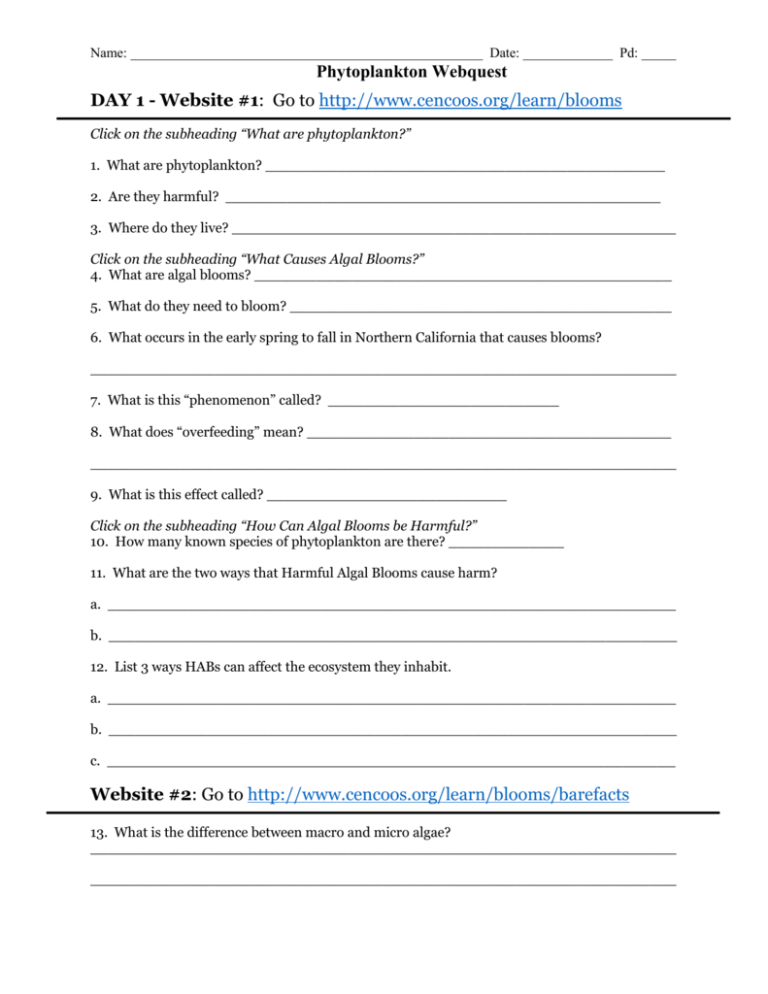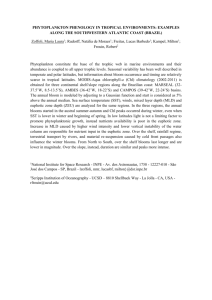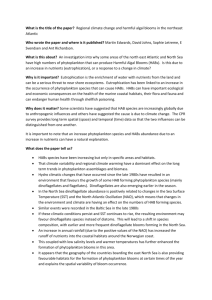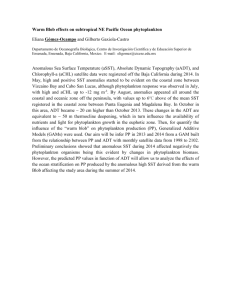phytoplanktonwebquest
advertisement

Name: ___________________________________________________ Date: _____________ Pd: _____ Phytoplankton Webquest DAY 1 - Website #1: Go to http://www.cencoos.org/learn/blooms Click on the subheading “What are phytoplankton?” 1. What are phytoplankton? _____________________________________________ 2. Are they harmful? _________________________________________________ 3. Where do they live? __________________________________________________ Click on the subheading “What Causes Algal Blooms?” 4. What are algal blooms? _______________________________________________ 5. What do they need to bloom? ___________________________________________ 6. What occurs in the early spring to fall in Northern California that causes blooms? __________________________________________________________________ 7. What is this “phenomenon” called? __________________________ 8. What does “overfeeding” mean? _________________________________________ __________________________________________________________________ 9. What is this effect called? ___________________________ Click on the subheading “How Can Algal Blooms be Harmful?” 10. How many known species of phytoplankton are there? _____________ 11. What are the two ways that Harmful Algal Blooms cause harm? a. ________________________________________________________________ b. ________________________________________________________________ 12. List 3 ways HABs can affect the ecosystem they inhabit. a. ________________________________________________________________ b. ________________________________________________________________ c. ________________________________________________________________ Website #2: Go to http://www.cencoos.org/learn/blooms/barefacts 13. What is the difference between macro and micro algae? __________________________________________________________________ __________________________________________________________________ Name: ___________________________________________________ Date: _____________ Pd: _____ Phytoplankton Webquest 14. Complete the following table: Diatoms (Click on link) Dinoflagellates (Click on link) Autotroph/Heterotroph? Both? Cell Size? Cell Wall Structure? Contain chloroplasts? Photopigments? Reproduction Ecological Roles Common genera (genus) 15. When you are on the dinoflagellate page, click on “toxicity.” Answer the following questions: (5pts) a. What is the name of the potent neurotoxin release by Gonyalaux? __________________ b. What type of poisoning does this toxin causes? _______________________________ c. What are the symptoms of this poisoning? __________________________________ __________________________________________________________________ d. List 2 interesting facts about this toxin: 1. ___________________________________________________________ 2. ___________________________________________________________ 16. Click the back button, what is the role of phytoplankton? __________________________________________________________________ __________________________________________________________________ Name: ___________________________________________________ Date: _____________ Pd: _____ Phytoplankton Webquest Website #3 Click on http://www.cencoos.org/learn/blooms/types 17. Why is the term “red tide” a misnomer? ______________________________ ____________________________________________________________ 18. Differentiate between the 3 types of algal blooms: Color Tide Caused by what species? One Fact Red Tide Green Tide Brown Tide 19. What are the 4 primary environmental factors needed for a bloom to occur? a. __________________________________________________________ b. __________________________________________________________ c. __________________________________________________________ d. __________________________________________________________ 20. Are all visible algal blooms toxic? ____ Name: ___________________________________________________ Date: _____________ Pd: _____ Phytoplankton Webquest DAY 2: Use the NASA Observatory Web http://earthobservatory.nasa.gov/site to find answers to the following: Use the “feature article” icon to locate the following articles on earthobservatory: http://earthobservatory.nasa.gov/Features/Phytoplankton/ “What are Phytoplankton?” 21. What is the Greek meaning of phytoplankton? _____________________________________________________________ 22. Draw the most common forms of phytoplankton, IN DETAIL!! (2 pts each) Cyanobacteria Diatom Dinoflagellate Green Algae Coccolithophore 23. Scroll down to the Importance of Phytoplankton. Click on the “Aquatic Food Web”. Choose 5 organisms, and create a food chain below: (5 pts) 24. Click the back button, what causes a “dead zone”? ____________________________________________________________ ____________________________________________________________ 25. What is the “biological carbon pump” and how much does it pump? ___________ ____________________________________________________________ 26. Look at the satellite pictures. How has El Nino influenced phytoplankton? _____________________________________________________________ _____________________________________________________________ 27. Scroll down to “Long-Term Changes in Phytoplankton”. What is causing the water to be “stratified”? What does this mean and what effects do it have on plankton populations? _____________________________________________________________ _____________________________________________________________ Name: ___________________________________________________ Date: _____________ Pd: _____ Phytoplankton Webquest B. “Hunting dangerous algae from space” http://earthobservatory.nasa.gov/Features/Redtide/ 28. What are algal blooms and what causes them? (describe the satellite photos) _____________________________________________________________ _____________________________________________________________ 29. Describe at least 4 effects these blooms may have on people or the environment.(4pt) a. ___________________________________________________________ b. ___________________________________________________________ c. ___________________________________________________________ d. ___________________________________________________________ C. “The Incredible Glowing Algae” http://earthobservatory.nasa.gov/Features/glowingalgae/ 30. What does recent technology enable scientists to observe about the algae? _____________________________________________________________ 31. What is primary productivity? _____________________________________________________________ 32. How does chlorophyll absorption affect the satellite images? _____________________________________________________________ 33. Give 3 reasons why monitoring fluorescence is beneficial to scientists? _____________________________________________________________ D. Go to “The North Atlantic Bloom” http://earthobservatory.nasa.gov/NaturalHazards/view.php?id=7830 34. What gives the water the electric blue color?____________________________ _____________________________________________________________ 35. What gives the water a deep green hue? ________________________________________________________ _____________________________________________________________ 36. What 2 countries are sandwiching this blooms? __________________________ and ______________________________ E. On the homepage for this website, under “Image of Today” search for “Plankton Bloom in Lake Titicaca” or click http://earthobservatory.nasa.gov/IOTD/view.php?id=4843 37. Why is Lake Titicaca prone to plankton blooms? _____________________________________________________________ 38. Observe and describe the satellite photographs. _____________________________________________________________ _____________________________________________________________ Name: ___________________________________________________ Date: _____________ Pd: _____ Phytoplankton Webquest PART 2: Red tides and Harmful Algae Use the website: http://www.whoi.edu/redtide/page.do?pid=9257 A. Using the pictures in red at the top left under “species”, choose 3 species (click on it): identify their scientific names and what health effects they cause. 39. Species #1: Scientific Name - ____________________________________ Syndrome - _______________________________________________ 40. Species #2: Scientific Name - __________________________________________ Syndrome - ____________________________________________ 41. Species #3: Scientific Name - _________________________________________ Syndrome - ____________________________________________ 42. Under “regions,” identify 4 places where visible phytoplankton blooms have occurred in this country. (4 pts) 1. _____________________________________ 2. _____________________________________ 3. _____________________________________ 4. _____________________________________ 43. Under the Species tab, click “Life Cycle.” Draw the life cycle of a dinoflagellate in the box below. Click on the numbers to get an explanation of what is happening at each stage and briefly describe it in your image. (5 pts) 44. Under Impacts tab, click on “Wildlife”. Describe 2 events where marine life were affected by HABS. 1. ________________________________________________________________ 2. ________________________________________________________________






